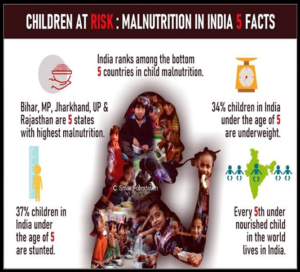FAO REPORT ON FOOD SECURITY AND NUTRITION
Why in the News?
The Recent FAO Report on Food Security and Nutrition highlights the state of Food Security in India and its comparison to other nations.
Source: Smile Foundation
Key Highlights of the Report:
Indian Affordability Decline:
- Over 74% of Indians couldn’t afford a healthy diet in 2021, a slight improvement from 76.2% in 2020.
- Rising food costs without concurrent income increases contribute to affordability challenges.
Regional Disparities:
- The report, “Regional Overview of Food Security and Nutrition 2023,” highlights challenges in the Asia Pacific region.
- In Pakistan, 82.2% faced difficulties affording healthy food, while in Bangladesh, the figure was 66.1%.
Impact of 5Fs Crisis:
- During the pandemic and the “5Fs” crisis (food, feed, fuel, fertilizer, and finance), the region witnessed severe consequences.
- The Asia Pacific region still grapples with protracted effects, representing half of the global undernourished population.
State of Nutrition in India:
- Undernourishment in India:
- India has 16.6% of its population grappling with undernourishment.
- This poses economic, social, and health challenges for the country.
- Child Health Challenges:
- Stunted growth is prevalent in 31.7% of children under the age of five.
- Wasting affects 18.7% of children .
| Stunting and Wasting
Stunting: Stunting is a condition of impaired growth and development in children, typically caused by chronic malnutrition, resulting in low height for age. Wasting: Wasting refers to a rapid weight loss or severe malnutrition in children, characterized by low weight for their height. It indicates acute undernutrition. |
- Anaemia in Women: Anaemia is a significant health concern, impacting 53% of women aged 15 to 49.
- Adult Obesity: In contrast, 1.6% of adults in India are classified as obese.
The FAO report underscores ongoing issues in achieving nutritional targets and the imperative for targeted interventions to address food security challenges in the region.

 Source: Smile Foundation
Source: Smile Foundation

